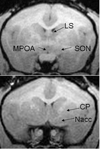Neural correlates of pair-bonding in a monogamous primate
- PMID: 17976540
- PMCID: PMC2387250
- DOI: 10.1016/j.brainres.2007.09.087
Neural correlates of pair-bonding in a monogamous primate
Abstract
The neurobiology of social bonding, despite its relevance to human mental health, has been studied primarily in rodents. In this study we used position emission tomography (PET), registered with structural magnetic resonance imaging (MRI) to investigate central glucose uptake in 17 males of a monogamous primate species, the titi monkey (Callicebus cupreus). Twelve pair-bonded males (including six with a lesion of the prefrontal cortex) and five lone males were scanned. The five lone males were re-scanned 48 h after pairing with a female. Significant differences in glucose uptake were found between males in long-term pair-bonds and lone males in areas including the nucleus accumbens, ventral pallidum, medial preoptic area, medial amygdala, and the supraoptic nucleus of the hypothalamus. In paired before and after comparisons, males showed significant changes following pairing in the right nucleus accumbens and ventral pallidum but not in other areas. Lesioned males showed significantly higher uptake in the posterior cingulate cortex than all other males. These results indicate some basic similarities between rodents and primates in the formation and maintenance of selective social bonds, but emphasize the importance of studying long-term maintenance in addition to short-term formation of social bonds.
Figures




References
-
- Aragona BJ, Liu Y, Yu YJ, Curtis JT, Detwiler JM, Insel TR, Wang ZX. Nucleus accumbens dopamine differentially mediates the formation and maintenance of monogamous pair bonds. Nat. Neurosci. 2005;9:133–139. - PubMed
-
- Aragona BJ, Wang ZX. The prairie vole (Microtus ochrogaster): an animal model for behavioral neuroendocrine research on pair bonding. I.L.A.R. Journal. 2004;45:35–45. - PubMed
-
- Argiolas A, Gessa GL. Central Functions of Oxytocin. Neurosci. Biobehav. Rev. 1991;15:217–231. - PubMed
-
- Aron A, Fisher H, Mashek DJ, Strong G, Li H, Brown LL. Reward, motivation, and emotion systems associated with early-stage intense romantic love. J. Neurophysiol. 2005;94:327–337. - PubMed
Publication types
MeSH terms
Substances
Grants and funding
LinkOut - more resources
Full Text Sources
Other Literature Sources

